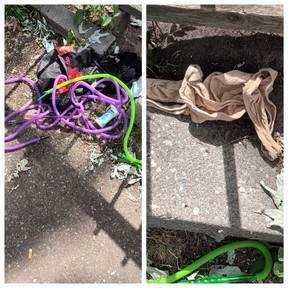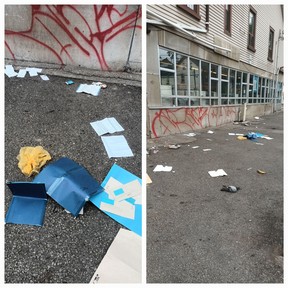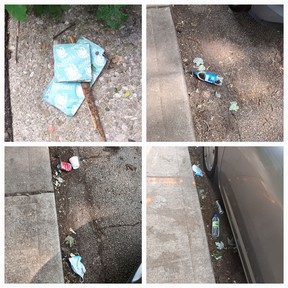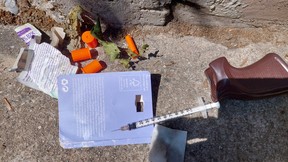恐怖!多伦多毒品注射站周围照片曝光 社区居民天天噩梦
两周前,一个周四的早晨,多伦多居民Matt去自家后面的车库,准备去拿他的回收箱。当时是早上8点左右,垃圾箱已经清空了,他想在上班前把它们收起来。
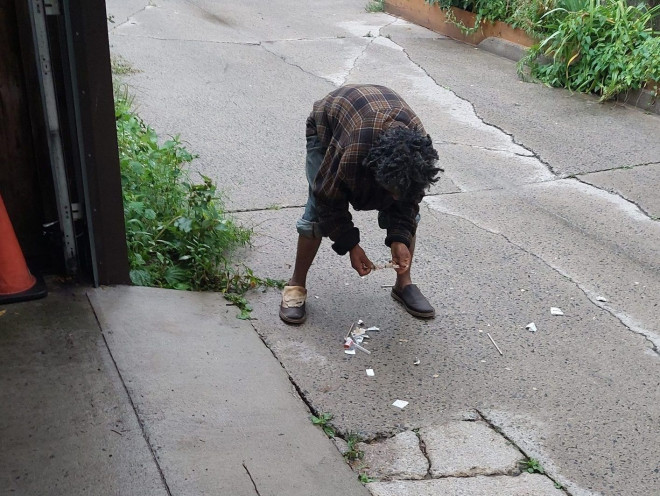
这个简单的事情,结果居然变成了与一个瘾君子的对抗,而且还被威胁要杀他。Matt似乎惊动了那个靠在车库门上的人,接下来发生的事情很可怕。
那人反复地喊道:“我要杀了你!我要杀了你!”
这名男子继续用手中的刀威胁Matt,并向他投掷玻璃裂缝管,随后离开了。可怕的是,对于居住在所谓毒品“安全注射站”和“安全供应点”附近的居民来说,这并不是一个孤立的事件,这些地点遍布我们的城市。
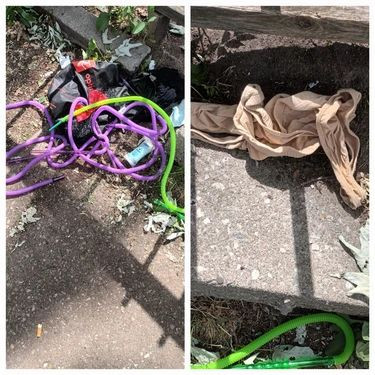
因为减少伤害而带来的伤害
7月7日,当毒贩在Queen St.和Carlaw Ave.的一个“毒品安全注射站”外争夺地盘时,44岁,同时也是两个孩子母亲的Karolina Huebner-Makurat被一颗流弹击中身亡,这一事件成为了人们关注的焦点。“减少伤害”(harm-reduction)项目的捍卫者声称,这起枪击事件与提供的“安全注射”服务没有任何联系,这种说法与现实脱节。
The South Riverdale Community Health Centre (SRCHC)经营着两个主站点:分别位于Queen和Carlaw,以及Sherbourne St.街。这些注射点附近的居民看惯了这些吸毒者的日常。
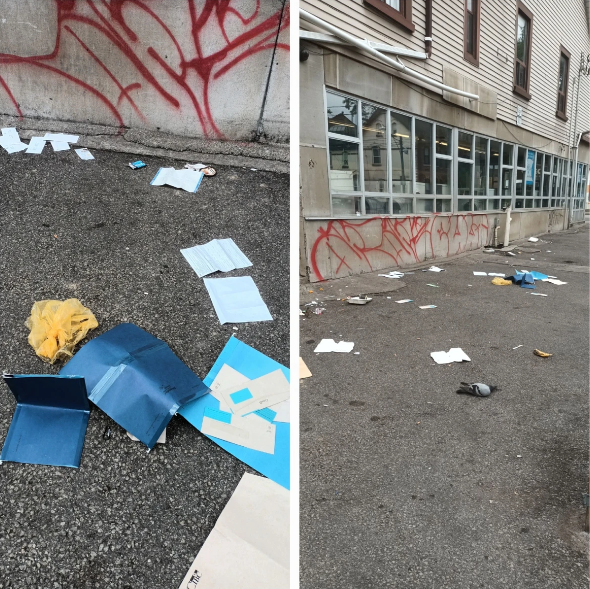
公共场所的性行为无时无刻不在发生,一个男人在不是自己居住的房子的台阶上,进行手淫并给自己注射毒品。当地居民离开他们的家时,可以看到有人手上还扎着针昏过去。甚至有人为了打下一针,不惜入室偷东西盗取财物。
Evelyn分享了一条朋友发来的短信,朋友本来打算来看她,但觉得不安全。
这位朋友发短信说:“有人在你门前,我不敢进去。”
Evelyn说,在她家门前发现昏倒的人并不罕见。
为了安全,被采访者的名字都做了更改,他们担心说出来而遭到报复或在家中遭到抗议。
这些人中的大多数都不希望这些注射点被关闭,但安全问题却一直没有解决。
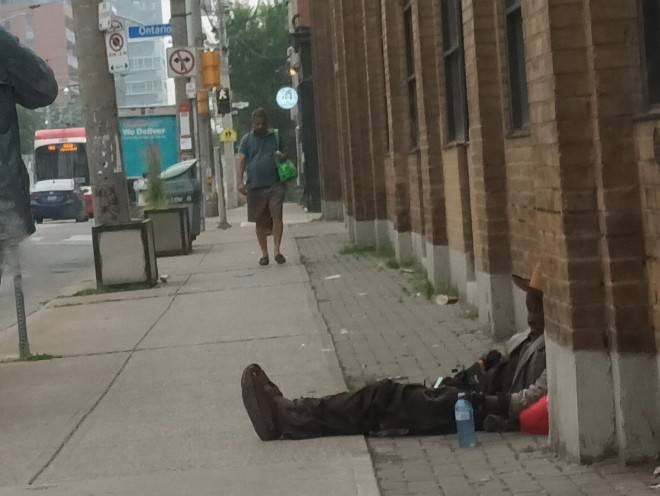
Jennifer描述了去年秋天的一个下午,她在家里听到了动静。在查看的过程中,她发现一个精神紧张的男人在她小儿子的房间里,想偷点什么东西,这样他可以把它卖掉换钱。
她的尖叫声吓住了男子,他随后逃跑。。值得庆幸的是,没有人受到伤害,但这个家庭现在觉得他们需要全天锁上门,以防止毒瘾者进入。
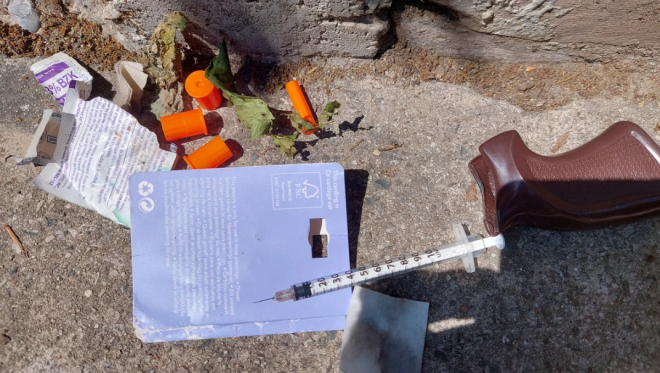
需要考虑安全注射地点对邻居的影响
由于离注射中心很近,居民们不得不处理废旧针头、可卡因管、避孕套、呕吐物、粪便等垃圾。然而,由于这些事件和垃圾并不是在中心发生的,因此它们不被视为是由设施及其运营引起的。
这些场所不仅提供了注射毒品的场所,而且还分发针头和其他相关用具,现在还提供药用级阿片类药物。这些注射点就像磁铁一样吸引着毒瘾者,也吸引着毒贩。这些中心的影响不能简单地通过使用这些设施的人的经历来衡量,还必须包括对居住在附近的居民的影响以及如何应对后果。
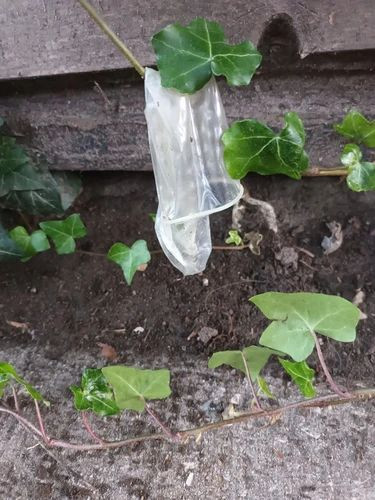
像 Matt,Evelyn和Jennifer这样的人并没有参与到关于SRCHC及其为吸毒者制定的计划的成功或失败的讨论中,但他们应该参与进来。
该中心表示,他们的理念是尊重吸毒者。他们自豪地说:“没有评判,没有期望,不会希望人们停止使用毒品。”
这一令人震惊的声明也许说明了为什么对社区和居住在市中心附近的人的影响被忽视了这么长时间。
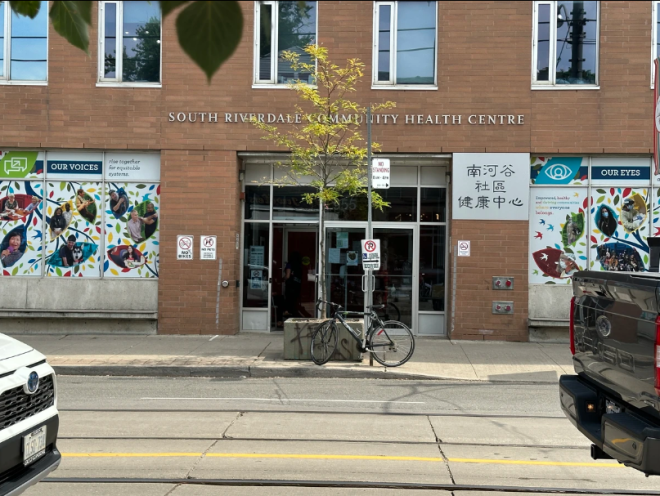
省级法规已经要求此类机构提供“现场或明确的成瘾治疗服务途径”,这似乎是SRCHC所缺乏的。这些规定还包括“解决社区关切并确保社区持续参与的要求”。
在Karolina的死亡和随之而来的社区愤怒之后,该省下令对Leslieville的SRCHC毒品注射点进行审查。让我们希望那些负责进行审查的人花时间和周围的居民交谈,花时间参观该地区。
LILLEY: Harm reduction programs unleash untold harm on neighbours
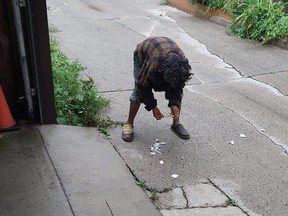
Two weeks ago, on a Thursday morning, Matt went to his garage in the back of his Toronto home to bring in his recycling bins. It was just after 8 a.m., the bins had been emptied and he wanted to tuck them away before going to work.
This simple task turned into a confrontation with a drug addict who threatened to kill him. Seems Matt disturbed the disturbed man who had been leaning against his garage door, and what followed was terrifying.
“I will kill you! I will kill you!” the man shouted, repeatedly.
The man went on to threaten Matt with the shivs in his hands and threw glass crack pipes at him before eventually walking away. Sadly, this isn’t an isolated incident for those who live near the “safe-injection” and “safe-supply” sites that populate our city.
Harm reduction brings harm
This issue came into focus on July 7 when Karolina Huebner-Makurat, a 44-year-old mother of two, was killed by a stray bullet as drug dealers argued over turf outside a “safe-injection” site at Queen St. and Carlaw Ave. Defenders of the “harm-reduction” program claim there is no way to connect the shooting to the “safe-injection” services on offer, a claim that is detached from reality.
The South Riverdale Community Health Centre (SRCHC) operates both the Queen and Carlaw facility and one on Sherbourne St., in Moss Park. Residents near these facilities are filled with stories about the impact the operations have on their daily lives. What they have to tell their fellow Torontonians is shocking.
Public sex acts at all hours, a man masturbating and injecting himself with drugs on the front steps of a home he doesn’t live in, people passed out with needles in their arms as local residents try to leave their homes — even what amounts to home invasions by those looking to steal what they can to score their next hit.
Evelyn shared a text message from a friend who was expected to come for a visit but decided it wasn’t safe.
“There are some people in front of your door and I am afraid to come in,” texted the friend.
Used needles, which can infect people who come into contact with them, are a common occurrence near harm reduction sites in Toronto.
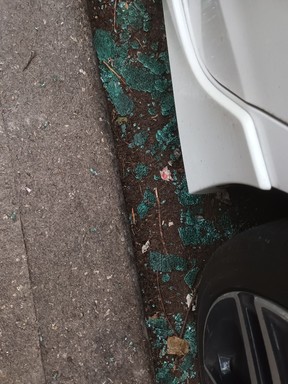 Broken glass at a car door. Vehicle break-ins are common near the harm reduction sites in Toronto.
Broken glass at a car door. Vehicle break-ins are common near the harm reduction sites in Toronto.
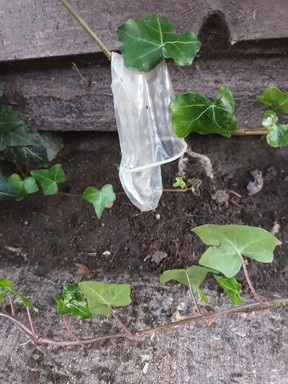 A used condom discarded by users of one of the Toronto's so-called harm reduction sites is a common sight for neighbours of the facilities.
A used condom discarded by users of one of the Toronto's so-called harm reduction sites is a common sight for neighbours of the facilities.
 A man smoking what appears to be a crack pipe in a children's play park in a residential area near one of Toronto's harm reduction sites.
A man smoking what appears to be a crack pipe in a children's play park in a residential area near one of Toronto's harm reduction sites.
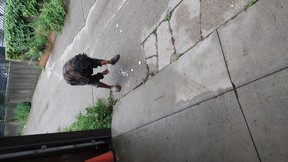 An east-end Toronto resident was startled to see this man in his back alley with drug paraphernalia after opening his garage and said he was threatened by him.
An east-end Toronto resident was startled to see this man in his back alley with drug paraphernalia after opening his garage and said he was threatened by him.
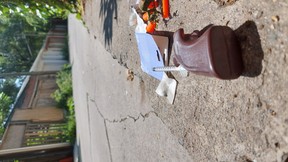 Drug paraphernalia, like needles, are regularly discarded in the side of the street or in alleyways near Toronto safe-injection sites.
Drug paraphernalia, like needles, are regularly discarded in the side of the street or in alleyways near Toronto safe-injection sites.
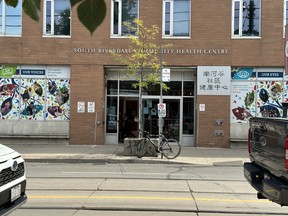 The South Riverdale Community Health Centre and safe injection site at 955 Queen St. E. on Friday, July 14, 2023. Photo by Jack Boland /Toronto Sun/Postmedia Network
The South Riverdale Community Health Centre and safe injection site at 955 Queen St. E. on Friday, July 14, 2023. Photo by Jack Boland /Toronto Sun/Postmedia Network
It’s not unusual, said Evelyn, to find people passed out in front of her home.
The names of the people in these stories have been changed at their request, concerned that they will face blowback or protests at their homes for speaking out. In hearing from those affected, it’s fascinating to learn how many believe in the safe injection sites and other harm-reduction programs, but feel the negative impact of these services on their communities — be it in Leslieville or Moss Park — are ignored.
Most of these people don’t want the programs shut down, but note there’s a failure to address the problems that come with them.
Jennifer described being at home one afternoon last fall when she heard a noise. As she investigated, she found a strung-out man in her young son’s room, looking for something to steal so he could sell it for his next hit.
Her screams startled the man who ran out of the home; thankfully, no one was hurt physically, but a family now feels they need to lock their doors at all hours of the day to keep addicts out.
Impact of safe injection sites on neighbours need to be considered
Residents have to deal with the litter of used needles, crack pipes, condoms, vomit, feces and more due to their proximity to these centres. Yet, because these incidents, and the litter, don’t happen at the centres, they aren’t counted as being caused by the facilities and their operations. But they should be; they must be.
These facilities, which not only give people a place to inject hard drugs but also hand out needles and other related paraphernalia, now also provide pharmaceutical-grade opioids. The sites act as magnets for users and for the drug dealers who prey on them. The impact of these centres can’t simply be measured by the experiences of those who use the facilities, but must also include the impact on residents who live near them and deal with the consequences.
People like Matt, Evelyn and Jennifer haven’t been part of the conversation about the success or failure of the SRCHC and its programming for drug addicts, but they should be.
The centre says their philosophy is about being respectful of those who use drugs. “No judgement, no expectations, no desire for people to stop using drugs,” they state proudly.
That shocking statement perhaps shows why the impact on the neighbourhood and those who live near the centre have been ignored for so long. Going forward, there should be judgement of the SRCHC; there should be expectations put upon them.
Provincial regulations already require such facilities to provide “Onsite or defined pathways to addictions treatment services,” something that appears to be lacking at the SRCHC. The regulations also include “requirements to address community concerns, and ensure ongoing community engagement.”
The province has ordered a review of the SRCHC’s drug programs in Leslieville in the wake of Karolina’s death and the ensuing community outrage. Let’s hope that those tasked with conducting the review take time to speak to those that live around it, take time to tour the area and look at more than what the centre’s staff want to show them.
Spending a few days in the areas around these sites and speaking to concerned residents would be truly eye-opening for anyone.
